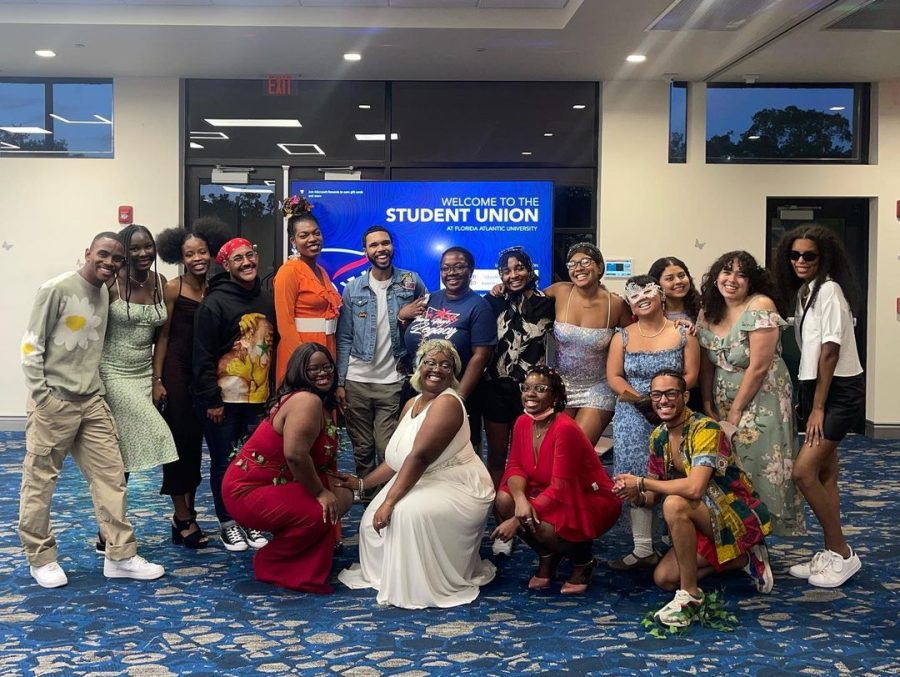BLISSS is bringing ballroom culture to FAU
BLISSS hosted its first Spring Pride week with their first-ever Essence of Spring Ballroom event.
March 20, 2023
BLISSS hosted a Spring Ballroom event serving as the final event of their first-ever Spring Pride week on March 17.
Ballroom is a subculture within the LGBTQ+ community that is known for its flamboyant fashion, exaggerated dancing, and competitive nature. Historically, ballroom culture emerged as an underground scene within the Black and Latino LGBTQ+ communities in New York City in the late 20th century, but rose to prominence in the ‘80s.
“I think it’s important for us to have these spaces where we can be ourselves and just be completely dramatic, and do what you know. This is a place where we don’t have to hide who we are. We can be queer and proud,” said Nodia Lindor, the president of BLISSS.
At colleges across the country, LGBTQ+ student groups and organizations are organizing Ballroom events for students. For example, The University of Texas, Austin has student organizations host a ballroom event monthly and Albion College in Michigan recently held a ballroom event. At FAU, the members of BLISS have taken on the role of bringing Ballroom culture to the students.
The members of BLISSS decided to start hosting Ball events due to the importance of the history of Ballroom had to Black and Latino LGBTQ+ communities as well as their love for the subculture itself. This is the second time that BLISS held a Ball themed event, the first time was their Halloween-themed Ball back in the 2022 Fall Semester.
“We wanted to bring Ballroom culture to LGBTQ+ individuals, There is a whole history behind it. There’s both good and bad, but it’s just a beautiful thing to bring to FAU,” said Kristen Mercy, the treasurer of BLISSS.
BLISSS took inspiration from the traditional aspects of Ballroom culture for their Ball themed competition. The winner of their respective categories was determined by a set of guest judges as well as the total accumulated points that the participants received.
Each of the categories was inspired by categories that are present in traditional Ballroom culture and its own different set of rules. The first they presented, “Runway” is among one the most prominent. Inspired by the runways of high fashion, this category originated back when high fashion restricted the presence of queer people of color in the industry.
Contestants were asked to give their best runway walk and to refrain from using other elements that are seen in other Ballroom categories, such as voguing and death drops. Other categories were given more freedom of expression and the event’s hosts would take time to explain a brief history of the significance of various categories. One included a category to present as masculine, which was traditionally performed by transmen to express themselves.
Another aspect that had been brought over was the houses that were used in Ballroom culture in New York City in the ‘80s and early ‘90s. House function serves as a collective or a found family for those who belong. Houses are run by “mothers” and “fathers” who are experienced in Ballroom culture and often consist of drag queens, gay men, and transwomen. Contestants at the event were introduced as members of houses such as the House of BLISSS or on occasion by their name.
The event was not just exclusive to just the participants, but members of the audience were also invited to perform in between categories or after the end of the competition itself, creating a small community for those involved in it.
According to Lindor planning the event had faced some challenges. Lindor shared they had three houses involved with their previous ball. However, due to timing conflicts, BLISSS members had to go on with just three participants in the competition. Despite the challenges, Lindor remains optimistic that BLISSS and the Ballroom events will continue to go strong.
“So hopefully next year, we’ll get more people we’re trying to figure out a better day for everyone. But as long as the organization continues to happen, I’ll be happy to throw more balls in the future,” said Lindor.
Melanie Gomez is the Features Editor for the University Press. For more information regarding this or other stories, you can contact her at melanieg200212@gmail.com or on her Instagram page @cupidfloats.






